Oman Air: Analyzing Organizational Changes and Management Systems
VerifiedAdded on 2022/09/17
|31
|8287
|31
Report
AI Summary
This report provides a comprehensive analysis of organizational changes within Oman Air, specifically focusing on the implementation of a new performance management system. The report begins with an executive summary and table of contents, followed by an introduction that sets the stage for the analysis. It explores the changing external environment, including political and legal factors, customer pressure, and competition. The impact of organizational structure and culture is discussed, alongside an examination of change management models, particularly Kotter’s model, and their practical implications. The report also assesses the impact of change on staff, addressing resistance to change and conflict management. An academic reflection on Lewin’s model of change is included, followed by recommendations for human resource management to ensure successful implementation. The report concludes by highlighting the necessity of organizational changes for growth and development, emphasizing the importance of effective communication and leadership in navigating associated challenges. References are provided at the end of the report.
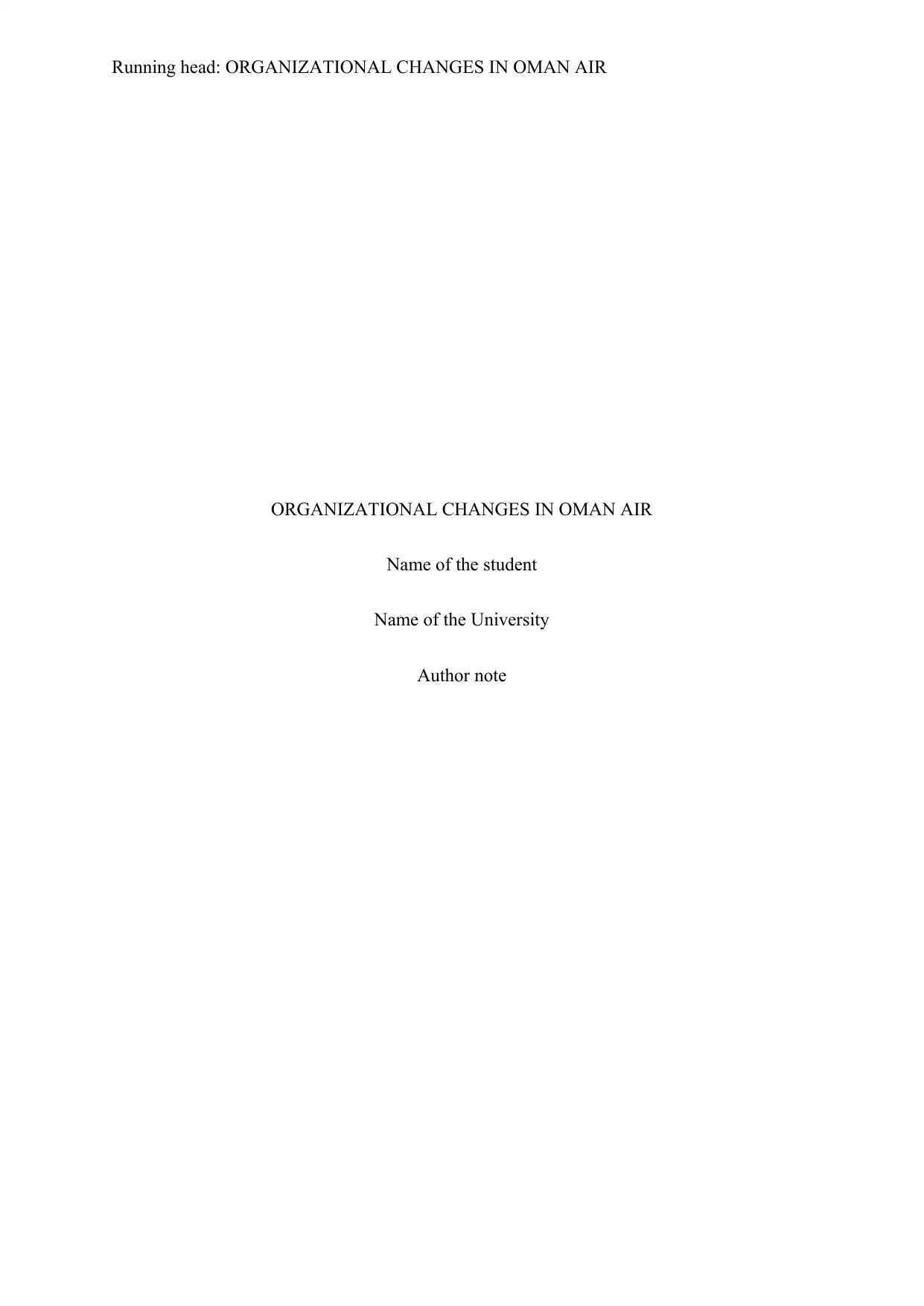
Running head: ORGANIZATIONAL CHANGES IN OMAN AIR
ORGANIZATIONAL CHANGES IN OMAN AIR
Name of the student
Name of the University
Author note
ORGANIZATIONAL CHANGES IN OMAN AIR
Name of the student
Name of the University
Author note
Paraphrase This Document
Need a fresh take? Get an instant paraphrase of this document with our AI Paraphraser
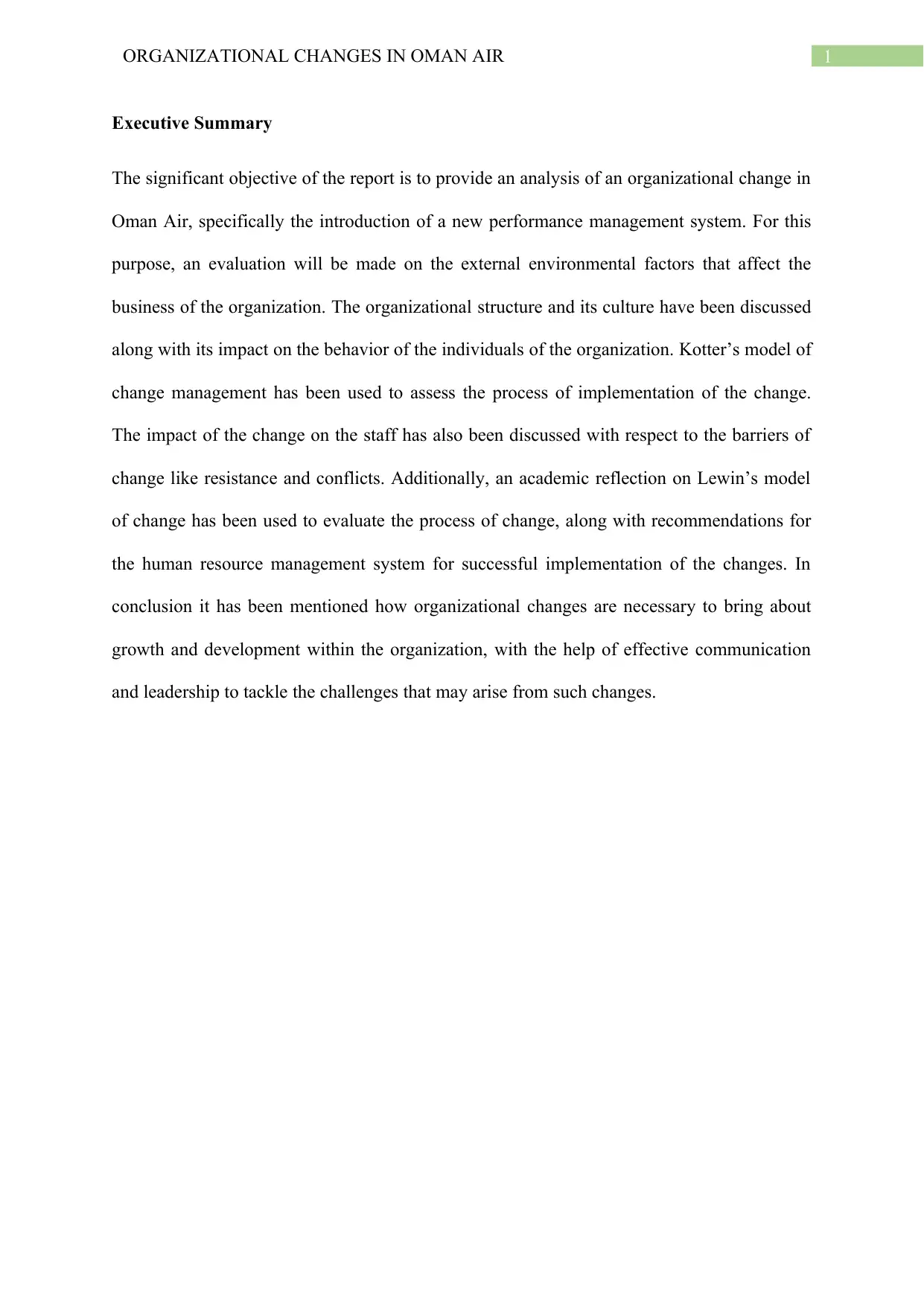
1ORGANIZATIONAL CHANGES IN OMAN AIR
Executive Summary
The significant objective of the report is to provide an analysis of an organizational change in
Oman Air, specifically the introduction of a new performance management system. For this
purpose, an evaluation will be made on the external environmental factors that affect the
business of the organization. The organizational structure and its culture have been discussed
along with its impact on the behavior of the individuals of the organization. Kotter’s model of
change management has been used to assess the process of implementation of the change.
The impact of the change on the staff has also been discussed with respect to the barriers of
change like resistance and conflicts. Additionally, an academic reflection on Lewin’s model
of change has been used to evaluate the process of change, along with recommendations for
the human resource management system for successful implementation of the changes. In
conclusion it has been mentioned how organizational changes are necessary to bring about
growth and development within the organization, with the help of effective communication
and leadership to tackle the challenges that may arise from such changes.
Executive Summary
The significant objective of the report is to provide an analysis of an organizational change in
Oman Air, specifically the introduction of a new performance management system. For this
purpose, an evaluation will be made on the external environmental factors that affect the
business of the organization. The organizational structure and its culture have been discussed
along with its impact on the behavior of the individuals of the organization. Kotter’s model of
change management has been used to assess the process of implementation of the change.
The impact of the change on the staff has also been discussed with respect to the barriers of
change like resistance and conflicts. Additionally, an academic reflection on Lewin’s model
of change has been used to evaluate the process of change, along with recommendations for
the human resource management system for successful implementation of the changes. In
conclusion it has been mentioned how organizational changes are necessary to bring about
growth and development within the organization, with the help of effective communication
and leadership to tackle the challenges that may arise from such changes.
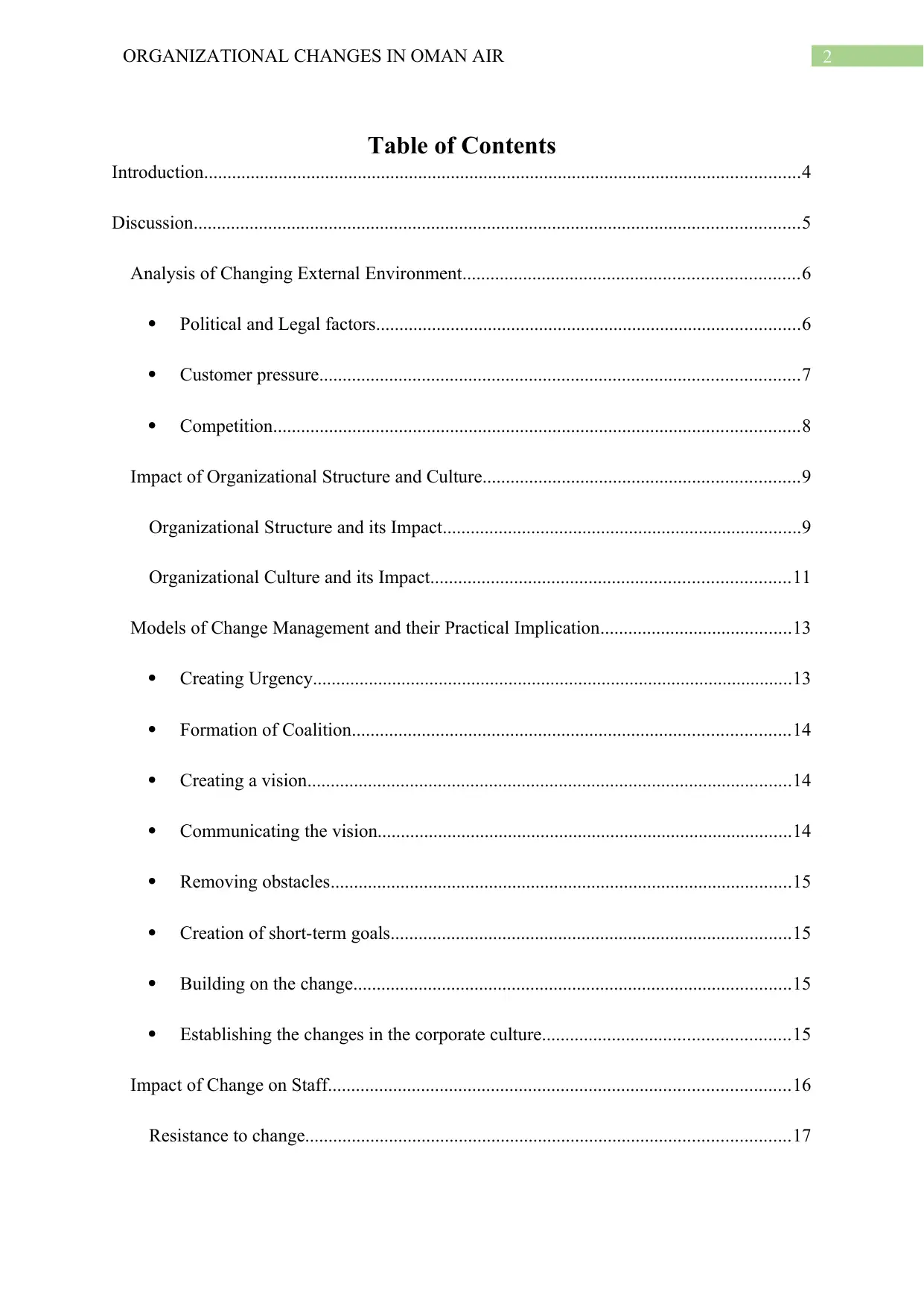
2ORGANIZATIONAL CHANGES IN OMAN AIR
Table of Contents
Introduction................................................................................................................................4
Discussion..................................................................................................................................5
Analysis of Changing External Environment........................................................................6
Political and Legal factors...........................................................................................6
Customer pressure.......................................................................................................7
Competition.................................................................................................................8
Impact of Organizational Structure and Culture....................................................................9
Organizational Structure and its Impact.............................................................................9
Organizational Culture and its Impact.............................................................................11
Models of Change Management and their Practical Implication.........................................13
Creating Urgency.......................................................................................................13
Formation of Coalition..............................................................................................14
Creating a vision........................................................................................................14
Communicating the vision.........................................................................................14
Removing obstacles...................................................................................................15
Creation of short-term goals......................................................................................15
Building on the change..............................................................................................15
Establishing the changes in the corporate culture.....................................................15
Impact of Change on Staff...................................................................................................16
Resistance to change........................................................................................................17
Table of Contents
Introduction................................................................................................................................4
Discussion..................................................................................................................................5
Analysis of Changing External Environment........................................................................6
Political and Legal factors...........................................................................................6
Customer pressure.......................................................................................................7
Competition.................................................................................................................8
Impact of Organizational Structure and Culture....................................................................9
Organizational Structure and its Impact.............................................................................9
Organizational Culture and its Impact.............................................................................11
Models of Change Management and their Practical Implication.........................................13
Creating Urgency.......................................................................................................13
Formation of Coalition..............................................................................................14
Creating a vision........................................................................................................14
Communicating the vision.........................................................................................14
Removing obstacles...................................................................................................15
Creation of short-term goals......................................................................................15
Building on the change..............................................................................................15
Establishing the changes in the corporate culture.....................................................15
Impact of Change on Staff...................................................................................................16
Resistance to change........................................................................................................17
⊘ This is a preview!⊘
Do you want full access?
Subscribe today to unlock all pages.

Trusted by 1+ million students worldwide
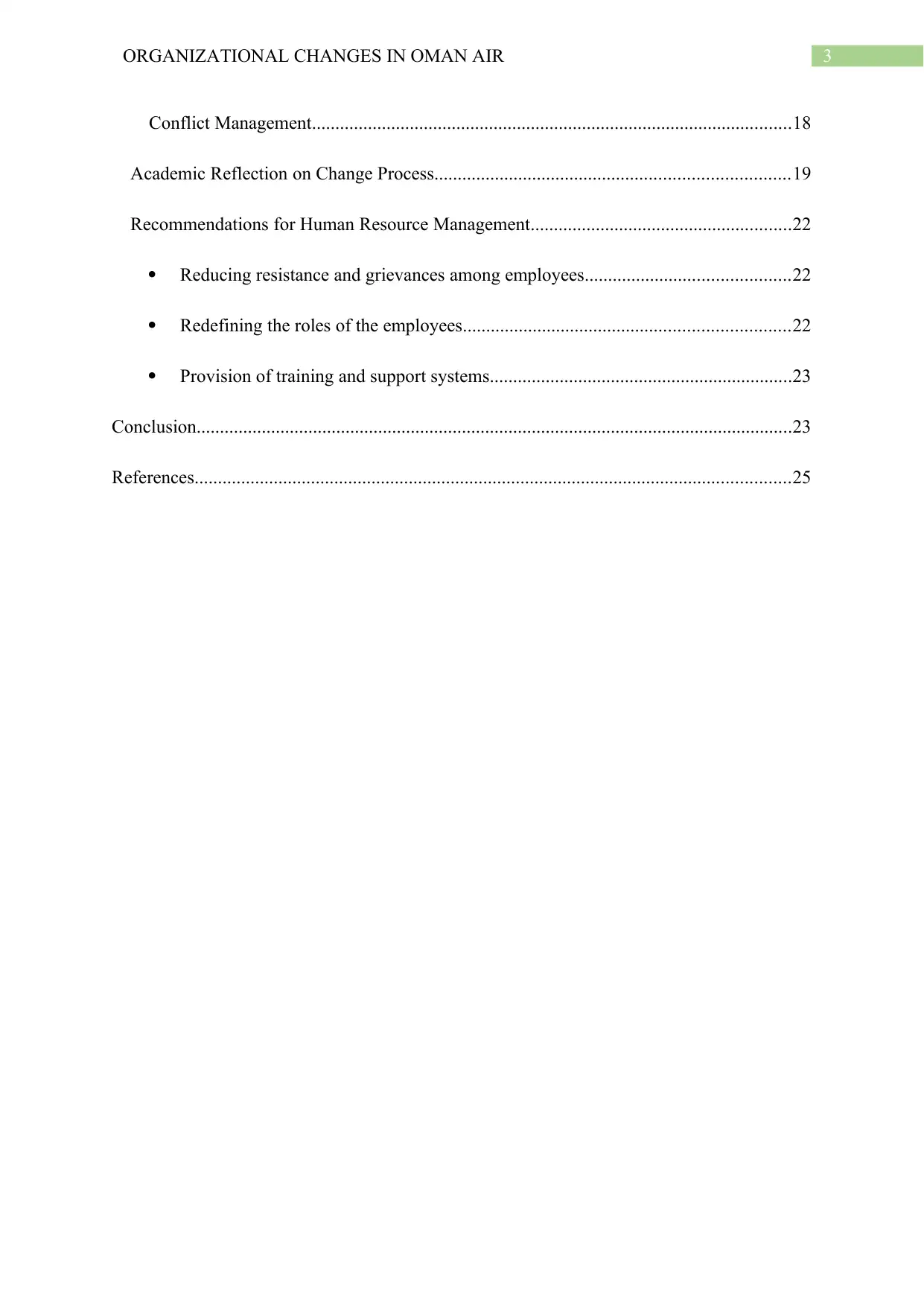
3ORGANIZATIONAL CHANGES IN OMAN AIR
Conflict Management.......................................................................................................18
Academic Reflection on Change Process............................................................................19
Recommendations for Human Resource Management........................................................22
Reducing resistance and grievances among employees............................................22
Redefining the roles of the employees......................................................................22
Provision of training and support systems.................................................................23
Conclusion................................................................................................................................23
References................................................................................................................................25
Conflict Management.......................................................................................................18
Academic Reflection on Change Process............................................................................19
Recommendations for Human Resource Management........................................................22
Reducing resistance and grievances among employees............................................22
Redefining the roles of the employees......................................................................22
Provision of training and support systems.................................................................23
Conclusion................................................................................................................................23
References................................................................................................................................25
Paraphrase This Document
Need a fresh take? Get an instant paraphrase of this document with our AI Paraphraser
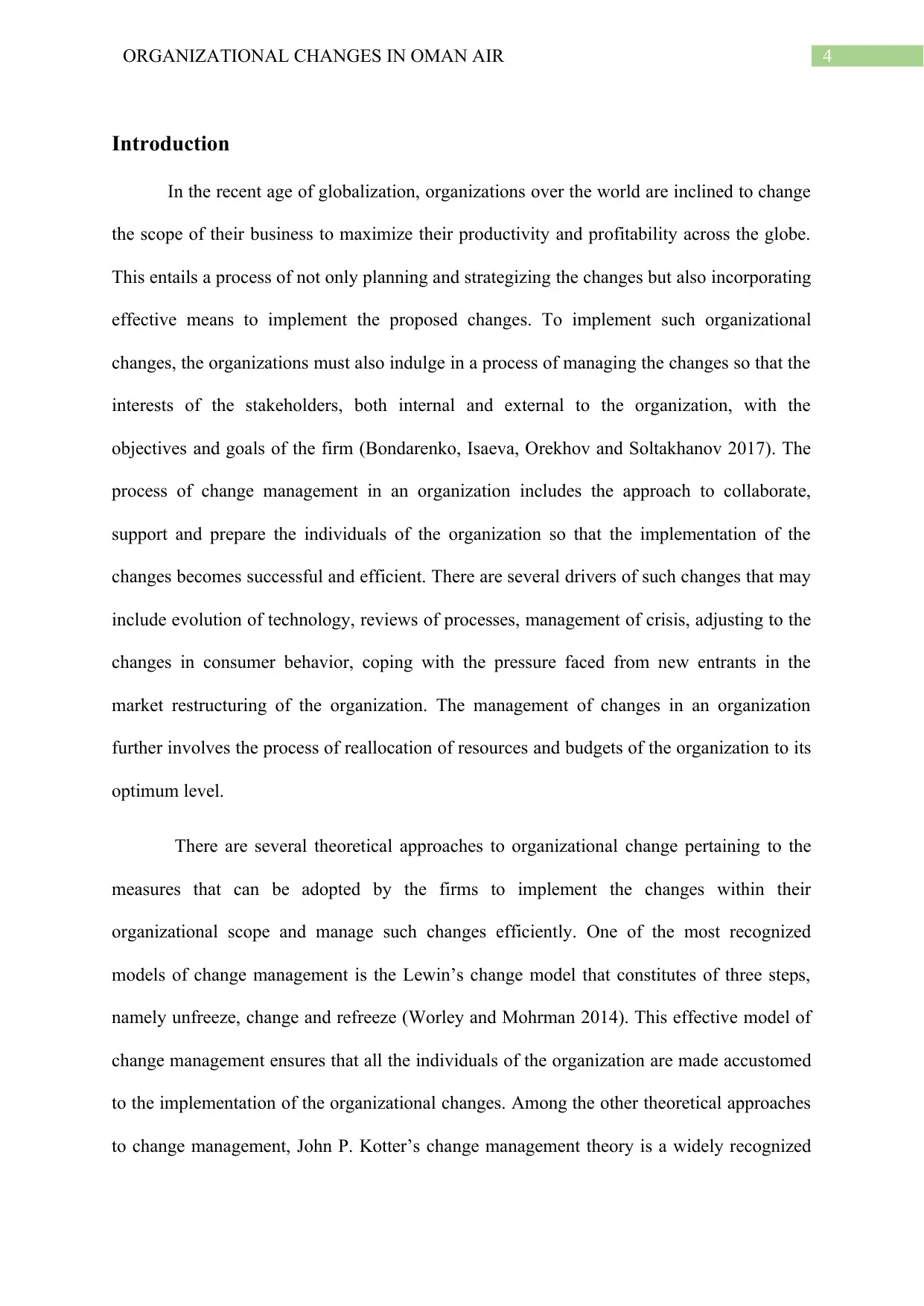
4ORGANIZATIONAL CHANGES IN OMAN AIR
Introduction
In the recent age of globalization, organizations over the world are inclined to change
the scope of their business to maximize their productivity and profitability across the globe.
This entails a process of not only planning and strategizing the changes but also incorporating
effective means to implement the proposed changes. To implement such organizational
changes, the organizations must also indulge in a process of managing the changes so that the
interests of the stakeholders, both internal and external to the organization, with the
objectives and goals of the firm (Bondarenko, Isaeva, Orekhov and Soltakhanov 2017). The
process of change management in an organization includes the approach to collaborate,
support and prepare the individuals of the organization so that the implementation of the
changes becomes successful and efficient. There are several drivers of such changes that may
include evolution of technology, reviews of processes, management of crisis, adjusting to the
changes in consumer behavior, coping with the pressure faced from new entrants in the
market restructuring of the organization. The management of changes in an organization
further involves the process of reallocation of resources and budgets of the organization to its
optimum level.
There are several theoretical approaches to organizational change pertaining to the
measures that can be adopted by the firms to implement the changes within their
organizational scope and manage such changes efficiently. One of the most recognized
models of change management is the Lewin’s change model that constitutes of three steps,
namely unfreeze, change and refreeze (Worley and Mohrman 2014). This effective model of
change management ensures that all the individuals of the organization are made accustomed
to the implementation of the organizational changes. Among the other theoretical approaches
to change management, John P. Kotter’s change management theory is a widely recognized
Introduction
In the recent age of globalization, organizations over the world are inclined to change
the scope of their business to maximize their productivity and profitability across the globe.
This entails a process of not only planning and strategizing the changes but also incorporating
effective means to implement the proposed changes. To implement such organizational
changes, the organizations must also indulge in a process of managing the changes so that the
interests of the stakeholders, both internal and external to the organization, with the
objectives and goals of the firm (Bondarenko, Isaeva, Orekhov and Soltakhanov 2017). The
process of change management in an organization includes the approach to collaborate,
support and prepare the individuals of the organization so that the implementation of the
changes becomes successful and efficient. There are several drivers of such changes that may
include evolution of technology, reviews of processes, management of crisis, adjusting to the
changes in consumer behavior, coping with the pressure faced from new entrants in the
market restructuring of the organization. The management of changes in an organization
further involves the process of reallocation of resources and budgets of the organization to its
optimum level.
There are several theoretical approaches to organizational change pertaining to the
measures that can be adopted by the firms to implement the changes within their
organizational scope and manage such changes efficiently. One of the most recognized
models of change management is the Lewin’s change model that constitutes of three steps,
namely unfreeze, change and refreeze (Worley and Mohrman 2014). This effective model of
change management ensures that all the individuals of the organization are made accustomed
to the implementation of the organizational changes. Among the other theoretical approaches
to change management, John P. Kotter’s change management theory is a widely recognized

5ORGANIZATIONAL CHANGES IN OMAN AIR
one, which is divided into eight elaborate stages each one focusing on the key principles of
response by the individuals of the organization (Ceptureanu 2015). These theories of change
management adequately assess the various aspects of the organization that are affected by
changes, namely the structure, culture and potential conflicts within the organizational scope.
Oman Air is one of the most reputed aviation firms in Oman and is often recognized
as its national airline. The airline is based at the Muscat International Airport and operates
international and domestic services for the passengers (Omanair.com 2019). The airline also
provides the system of air taxi in the region, providing services of short flights on the demand
of the customers, along with services of charter flights. The airline is recognized as being part
of the Arab Air Carriers Organization, which is a non-profit organization constituting of
thirty airline members from eighteen constituent countries (Jalagat, Dalluay, Al-Zadjali and
Al-Abdullah 2017). The organization has been subject to several changes over the years that
include the recapitalization of the airline by the government of Oman, introduction of several
Airbus A330s in tis airline facilities, introduction of Wi-fi and mobile phone internet facilities
on certain selected routes. However, one of the most recent organizational changes in the
Oman Air was the introduction of a new performance management system to induce
awareness among the individuals of the airline about measures to improve their performance
and management skills so as to integrate the needs of the customers with the goals and
objectives of the airline (Al Rawas 2014). The report will further analyze this organizational
change in Oman Air with respect to the approaches of change management that can be used
for the successful implementation of the change.
Discussion
The aviation sector is a booming industry in the world that is constantly and
persistently developing to meet the changing patterns of the market, expectations of the
one, which is divided into eight elaborate stages each one focusing on the key principles of
response by the individuals of the organization (Ceptureanu 2015). These theories of change
management adequately assess the various aspects of the organization that are affected by
changes, namely the structure, culture and potential conflicts within the organizational scope.
Oman Air is one of the most reputed aviation firms in Oman and is often recognized
as its national airline. The airline is based at the Muscat International Airport and operates
international and domestic services for the passengers (Omanair.com 2019). The airline also
provides the system of air taxi in the region, providing services of short flights on the demand
of the customers, along with services of charter flights. The airline is recognized as being part
of the Arab Air Carriers Organization, which is a non-profit organization constituting of
thirty airline members from eighteen constituent countries (Jalagat, Dalluay, Al-Zadjali and
Al-Abdullah 2017). The organization has been subject to several changes over the years that
include the recapitalization of the airline by the government of Oman, introduction of several
Airbus A330s in tis airline facilities, introduction of Wi-fi and mobile phone internet facilities
on certain selected routes. However, one of the most recent organizational changes in the
Oman Air was the introduction of a new performance management system to induce
awareness among the individuals of the airline about measures to improve their performance
and management skills so as to integrate the needs of the customers with the goals and
objectives of the airline (Al Rawas 2014). The report will further analyze this organizational
change in Oman Air with respect to the approaches of change management that can be used
for the successful implementation of the change.
Discussion
The aviation sector is a booming industry in the world that is constantly and
persistently developing to meet the changing patterns of the market, expectations of the
⊘ This is a preview!⊘
Do you want full access?
Subscribe today to unlock all pages.

Trusted by 1+ million students worldwide
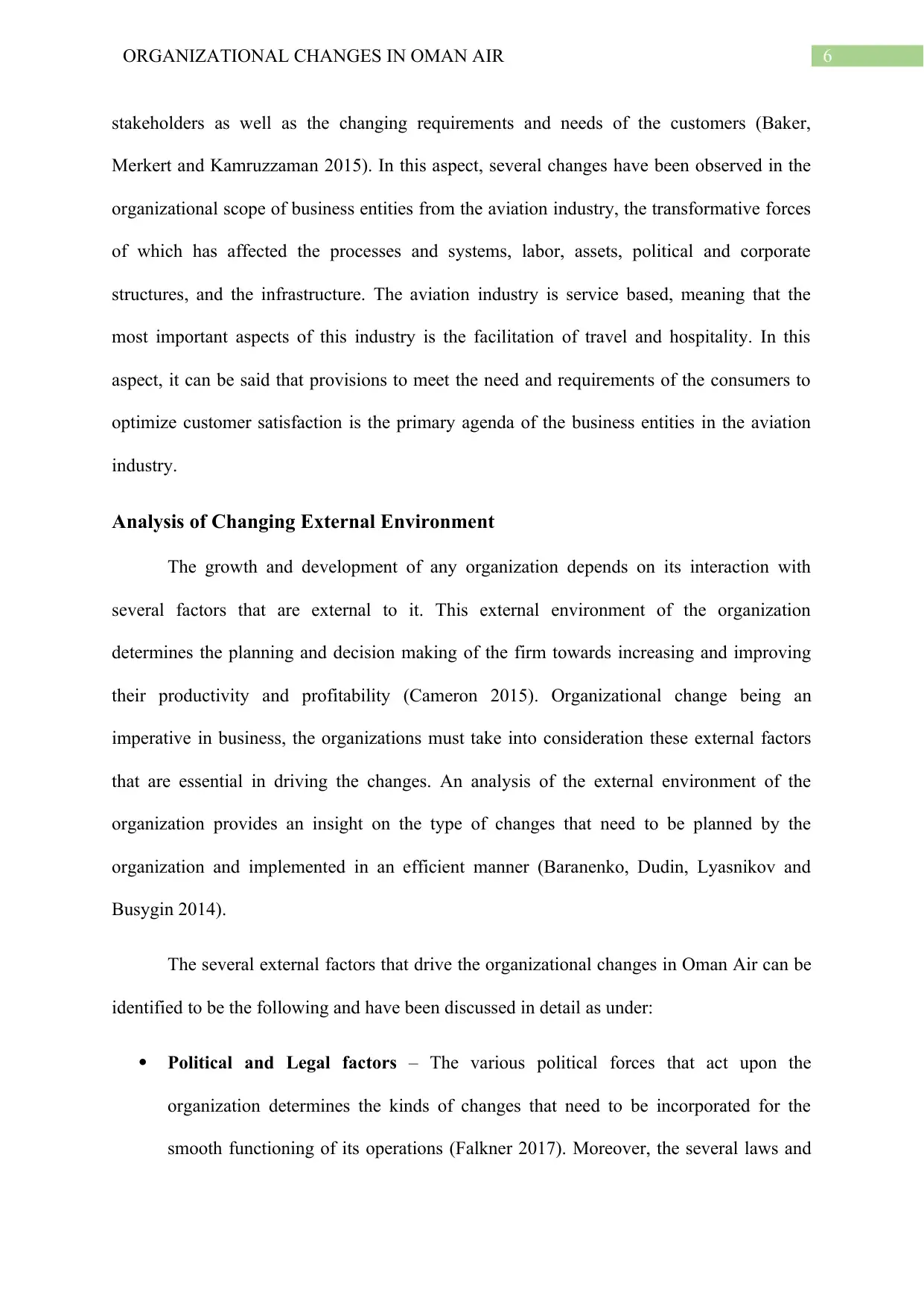
6ORGANIZATIONAL CHANGES IN OMAN AIR
stakeholders as well as the changing requirements and needs of the customers (Baker,
Merkert and Kamruzzaman 2015). In this aspect, several changes have been observed in the
organizational scope of business entities from the aviation industry, the transformative forces
of which has affected the processes and systems, labor, assets, political and corporate
structures, and the infrastructure. The aviation industry is service based, meaning that the
most important aspects of this industry is the facilitation of travel and hospitality. In this
aspect, it can be said that provisions to meet the need and requirements of the consumers to
optimize customer satisfaction is the primary agenda of the business entities in the aviation
industry.
Analysis of Changing External Environment
The growth and development of any organization depends on its interaction with
several factors that are external to it. This external environment of the organization
determines the planning and decision making of the firm towards increasing and improving
their productivity and profitability (Cameron 2015). Organizational change being an
imperative in business, the organizations must take into consideration these external factors
that are essential in driving the changes. An analysis of the external environment of the
organization provides an insight on the type of changes that need to be planned by the
organization and implemented in an efficient manner (Baranenko, Dudin, Lyasnikov and
Busygin 2014).
The several external factors that drive the organizational changes in Oman Air can be
identified to be the following and have been discussed in detail as under:
Political and Legal factors – The various political forces that act upon the
organization determines the kinds of changes that need to be incorporated for the
smooth functioning of its operations (Falkner 2017). Moreover, the several laws and
stakeholders as well as the changing requirements and needs of the customers (Baker,
Merkert and Kamruzzaman 2015). In this aspect, several changes have been observed in the
organizational scope of business entities from the aviation industry, the transformative forces
of which has affected the processes and systems, labor, assets, political and corporate
structures, and the infrastructure. The aviation industry is service based, meaning that the
most important aspects of this industry is the facilitation of travel and hospitality. In this
aspect, it can be said that provisions to meet the need and requirements of the consumers to
optimize customer satisfaction is the primary agenda of the business entities in the aviation
industry.
Analysis of Changing External Environment
The growth and development of any organization depends on its interaction with
several factors that are external to it. This external environment of the organization
determines the planning and decision making of the firm towards increasing and improving
their productivity and profitability (Cameron 2015). Organizational change being an
imperative in business, the organizations must take into consideration these external factors
that are essential in driving the changes. An analysis of the external environment of the
organization provides an insight on the type of changes that need to be planned by the
organization and implemented in an efficient manner (Baranenko, Dudin, Lyasnikov and
Busygin 2014).
The several external factors that drive the organizational changes in Oman Air can be
identified to be the following and have been discussed in detail as under:
Political and Legal factors – The various political forces that act upon the
organization determines the kinds of changes that need to be incorporated for the
smooth functioning of its operations (Falkner 2017). Moreover, the several laws and
Paraphrase This Document
Need a fresh take? Get an instant paraphrase of this document with our AI Paraphraser
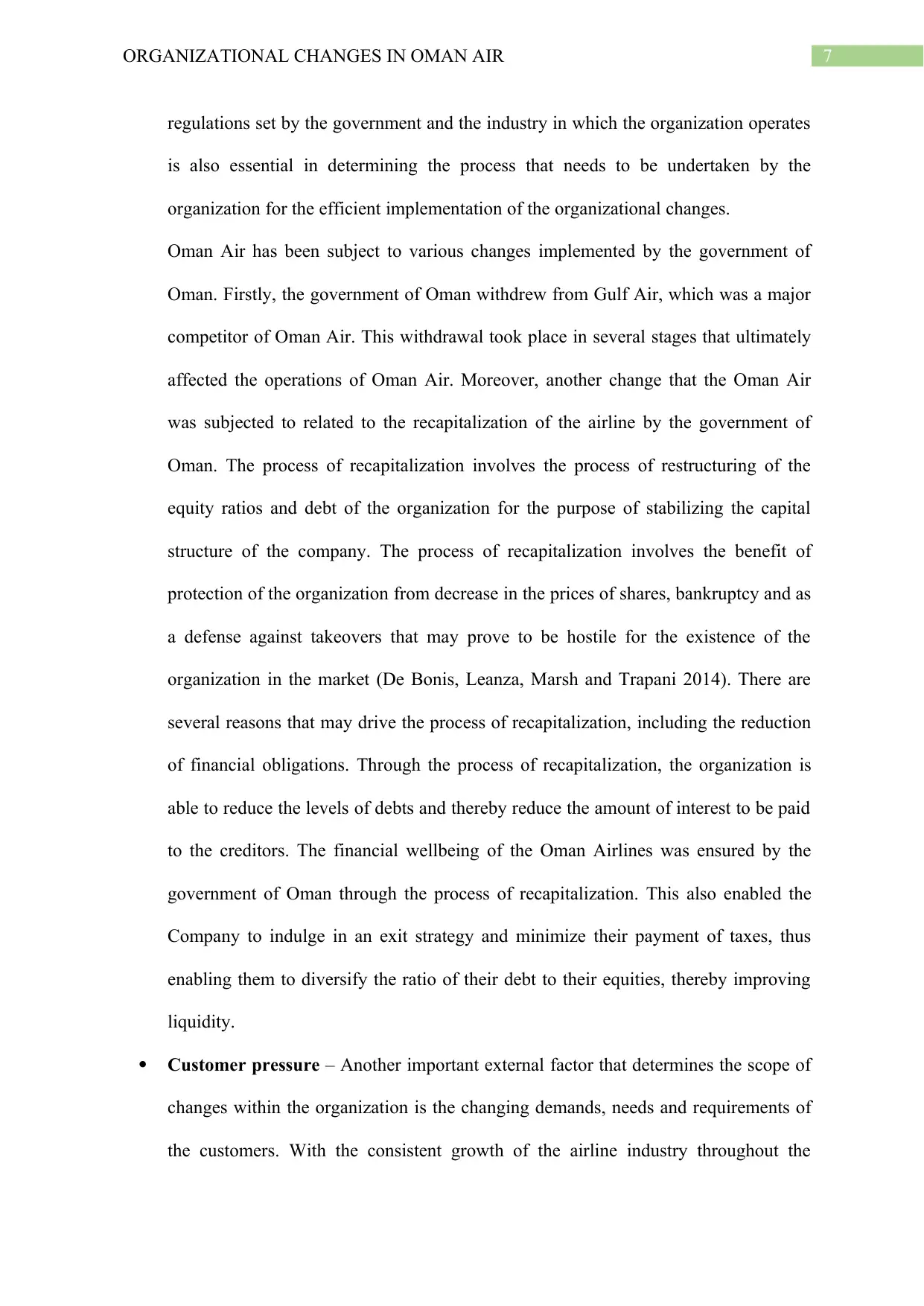
7ORGANIZATIONAL CHANGES IN OMAN AIR
regulations set by the government and the industry in which the organization operates
is also essential in determining the process that needs to be undertaken by the
organization for the efficient implementation of the organizational changes.
Oman Air has been subject to various changes implemented by the government of
Oman. Firstly, the government of Oman withdrew from Gulf Air, which was a major
competitor of Oman Air. This withdrawal took place in several stages that ultimately
affected the operations of Oman Air. Moreover, another change that the Oman Air
was subjected to related to the recapitalization of the airline by the government of
Oman. The process of recapitalization involves the process of restructuring of the
equity ratios and debt of the organization for the purpose of stabilizing the capital
structure of the company. The process of recapitalization involves the benefit of
protection of the organization from decrease in the prices of shares, bankruptcy and as
a defense against takeovers that may prove to be hostile for the existence of the
organization in the market (De Bonis, Leanza, Marsh and Trapani 2014). There are
several reasons that may drive the process of recapitalization, including the reduction
of financial obligations. Through the process of recapitalization, the organization is
able to reduce the levels of debts and thereby reduce the amount of interest to be paid
to the creditors. The financial wellbeing of the Oman Airlines was ensured by the
government of Oman through the process of recapitalization. This also enabled the
Company to indulge in an exit strategy and minimize their payment of taxes, thus
enabling them to diversify the ratio of their debt to their equities, thereby improving
liquidity.
Customer pressure – Another important external factor that determines the scope of
changes within the organization is the changing demands, needs and requirements of
the customers. With the consistent growth of the airline industry throughout the
regulations set by the government and the industry in which the organization operates
is also essential in determining the process that needs to be undertaken by the
organization for the efficient implementation of the organizational changes.
Oman Air has been subject to various changes implemented by the government of
Oman. Firstly, the government of Oman withdrew from Gulf Air, which was a major
competitor of Oman Air. This withdrawal took place in several stages that ultimately
affected the operations of Oman Air. Moreover, another change that the Oman Air
was subjected to related to the recapitalization of the airline by the government of
Oman. The process of recapitalization involves the process of restructuring of the
equity ratios and debt of the organization for the purpose of stabilizing the capital
structure of the company. The process of recapitalization involves the benefit of
protection of the organization from decrease in the prices of shares, bankruptcy and as
a defense against takeovers that may prove to be hostile for the existence of the
organization in the market (De Bonis, Leanza, Marsh and Trapani 2014). There are
several reasons that may drive the process of recapitalization, including the reduction
of financial obligations. Through the process of recapitalization, the organization is
able to reduce the levels of debts and thereby reduce the amount of interest to be paid
to the creditors. The financial wellbeing of the Oman Airlines was ensured by the
government of Oman through the process of recapitalization. This also enabled the
Company to indulge in an exit strategy and minimize their payment of taxes, thus
enabling them to diversify the ratio of their debt to their equities, thereby improving
liquidity.
Customer pressure – Another important external factor that determines the scope of
changes within the organization is the changing demands, needs and requirements of
the customers. With the consistent growth of the airline industry throughout the
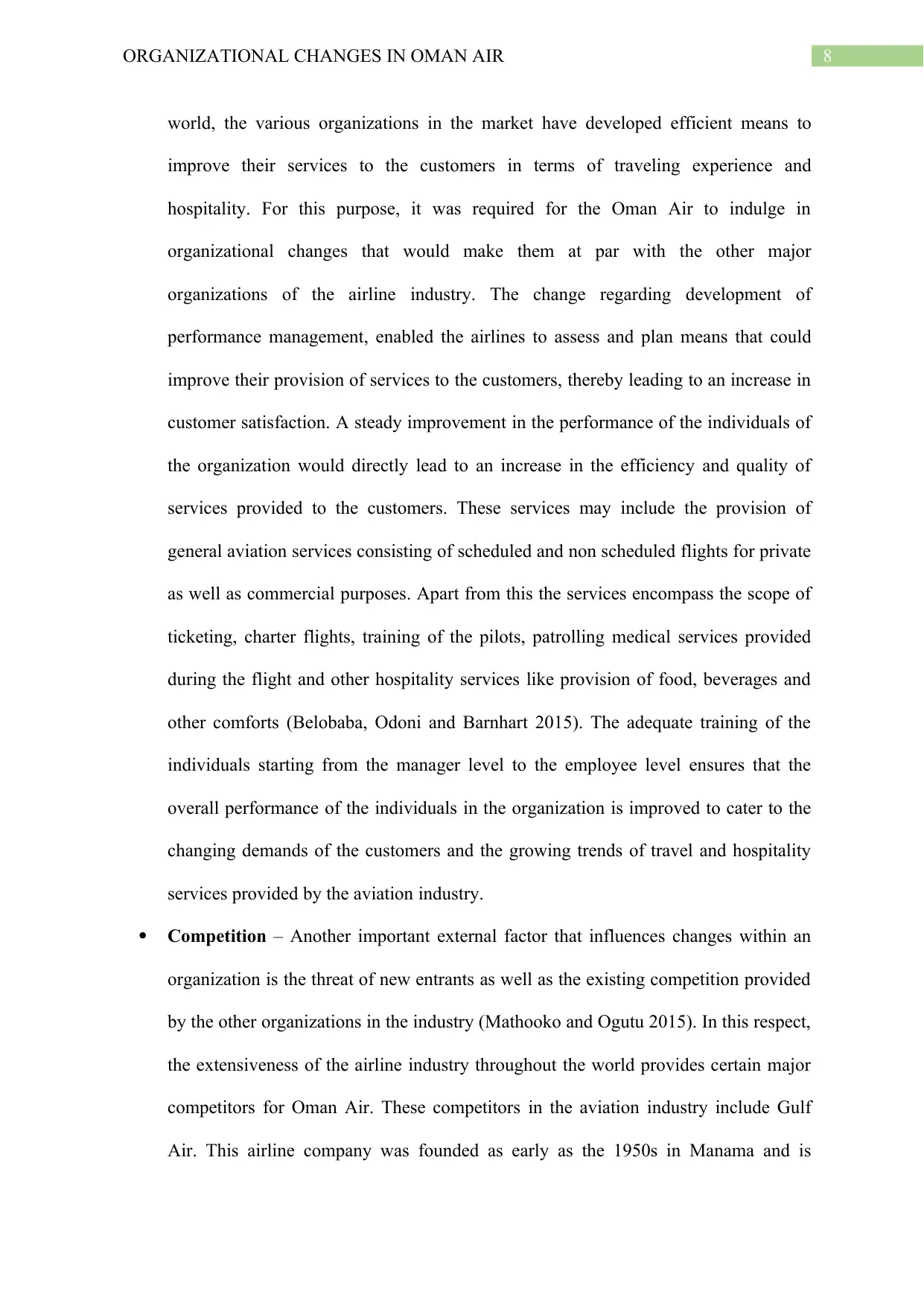
8ORGANIZATIONAL CHANGES IN OMAN AIR
world, the various organizations in the market have developed efficient means to
improve their services to the customers in terms of traveling experience and
hospitality. For this purpose, it was required for the Oman Air to indulge in
organizational changes that would make them at par with the other major
organizations of the airline industry. The change regarding development of
performance management, enabled the airlines to assess and plan means that could
improve their provision of services to the customers, thereby leading to an increase in
customer satisfaction. A steady improvement in the performance of the individuals of
the organization would directly lead to an increase in the efficiency and quality of
services provided to the customers. These services may include the provision of
general aviation services consisting of scheduled and non scheduled flights for private
as well as commercial purposes. Apart from this the services encompass the scope of
ticketing, charter flights, training of the pilots, patrolling medical services provided
during the flight and other hospitality services like provision of food, beverages and
other comforts (Belobaba, Odoni and Barnhart 2015). The adequate training of the
individuals starting from the manager level to the employee level ensures that the
overall performance of the individuals in the organization is improved to cater to the
changing demands of the customers and the growing trends of travel and hospitality
services provided by the aviation industry.
Competition – Another important external factor that influences changes within an
organization is the threat of new entrants as well as the existing competition provided
by the other organizations in the industry (Mathooko and Ogutu 2015). In this respect,
the extensiveness of the airline industry throughout the world provides certain major
competitors for Oman Air. These competitors in the aviation industry include Gulf
Air. This airline company was founded as early as the 1950s in Manama and is
world, the various organizations in the market have developed efficient means to
improve their services to the customers in terms of traveling experience and
hospitality. For this purpose, it was required for the Oman Air to indulge in
organizational changes that would make them at par with the other major
organizations of the airline industry. The change regarding development of
performance management, enabled the airlines to assess and plan means that could
improve their provision of services to the customers, thereby leading to an increase in
customer satisfaction. A steady improvement in the performance of the individuals of
the organization would directly lead to an increase in the efficiency and quality of
services provided to the customers. These services may include the provision of
general aviation services consisting of scheduled and non scheduled flights for private
as well as commercial purposes. Apart from this the services encompass the scope of
ticketing, charter flights, training of the pilots, patrolling medical services provided
during the flight and other hospitality services like provision of food, beverages and
other comforts (Belobaba, Odoni and Barnhart 2015). The adequate training of the
individuals starting from the manager level to the employee level ensures that the
overall performance of the individuals in the organization is improved to cater to the
changing demands of the customers and the growing trends of travel and hospitality
services provided by the aviation industry.
Competition – Another important external factor that influences changes within an
organization is the threat of new entrants as well as the existing competition provided
by the other organizations in the industry (Mathooko and Ogutu 2015). In this respect,
the extensiveness of the airline industry throughout the world provides certain major
competitors for Oman Air. These competitors in the aviation industry include Gulf
Air. This airline company was founded as early as the 1950s in Manama and is
⊘ This is a preview!⊘
Do you want full access?
Subscribe today to unlock all pages.

Trusted by 1+ million students worldwide
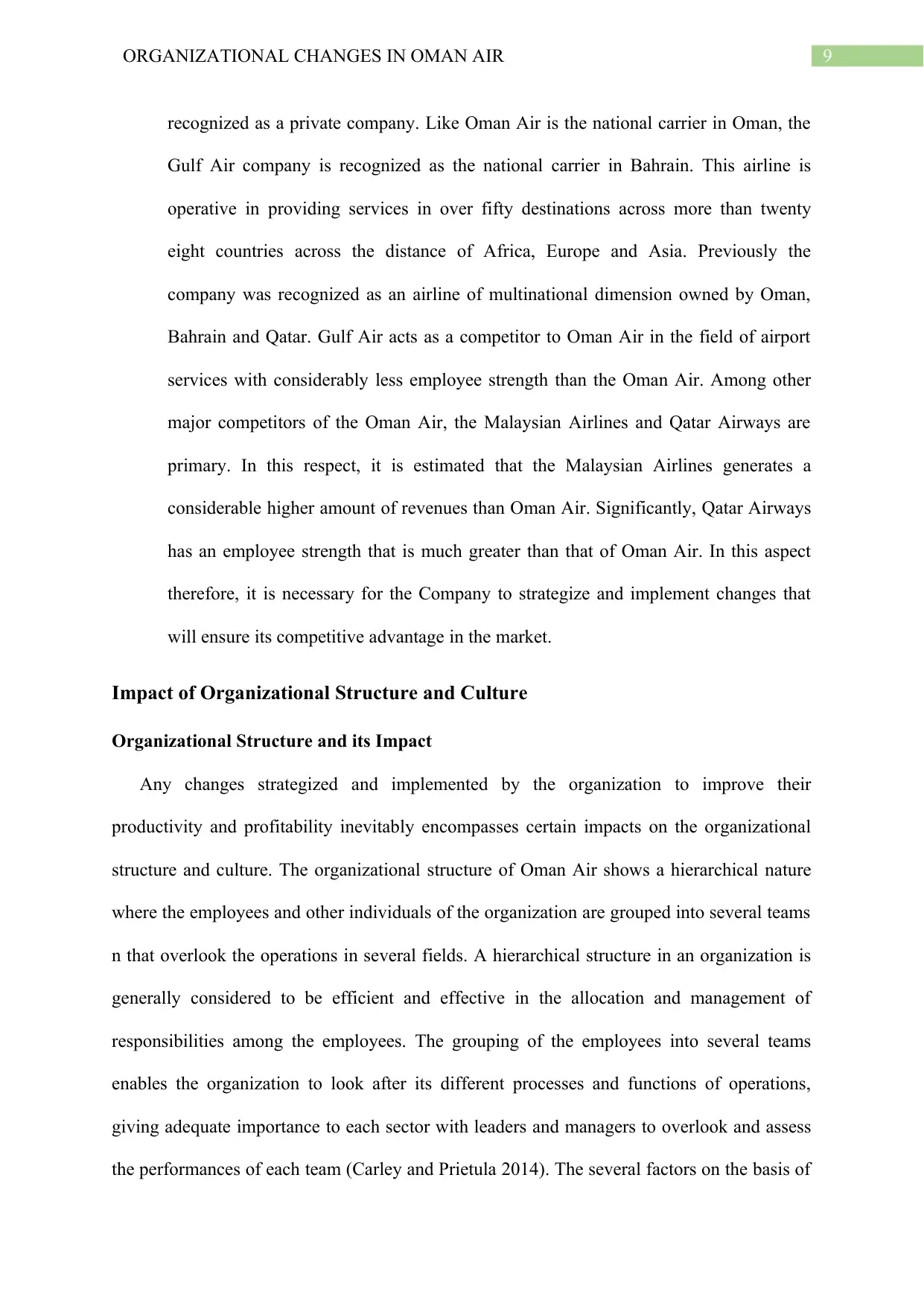
9ORGANIZATIONAL CHANGES IN OMAN AIR
recognized as a private company. Like Oman Air is the national carrier in Oman, the
Gulf Air company is recognized as the national carrier in Bahrain. This airline is
operative in providing services in over fifty destinations across more than twenty
eight countries across the distance of Africa, Europe and Asia. Previously the
company was recognized as an airline of multinational dimension owned by Oman,
Bahrain and Qatar. Gulf Air acts as a competitor to Oman Air in the field of airport
services with considerably less employee strength than the Oman Air. Among other
major competitors of the Oman Air, the Malaysian Airlines and Qatar Airways are
primary. In this respect, it is estimated that the Malaysian Airlines generates a
considerable higher amount of revenues than Oman Air. Significantly, Qatar Airways
has an employee strength that is much greater than that of Oman Air. In this aspect
therefore, it is necessary for the Company to strategize and implement changes that
will ensure its competitive advantage in the market.
Impact of Organizational Structure and Culture
Organizational Structure and its Impact
Any changes strategized and implemented by the organization to improve their
productivity and profitability inevitably encompasses certain impacts on the organizational
structure and culture. The organizational structure of Oman Air shows a hierarchical nature
where the employees and other individuals of the organization are grouped into several teams
n that overlook the operations in several fields. A hierarchical structure in an organization is
generally considered to be efficient and effective in the allocation and management of
responsibilities among the employees. The grouping of the employees into several teams
enables the organization to look after its different processes and functions of operations,
giving adequate importance to each sector with leaders and managers to overlook and assess
the performances of each team (Carley and Prietula 2014). The several factors on the basis of
recognized as a private company. Like Oman Air is the national carrier in Oman, the
Gulf Air company is recognized as the national carrier in Bahrain. This airline is
operative in providing services in over fifty destinations across more than twenty
eight countries across the distance of Africa, Europe and Asia. Previously the
company was recognized as an airline of multinational dimension owned by Oman,
Bahrain and Qatar. Gulf Air acts as a competitor to Oman Air in the field of airport
services with considerably less employee strength than the Oman Air. Among other
major competitors of the Oman Air, the Malaysian Airlines and Qatar Airways are
primary. In this respect, it is estimated that the Malaysian Airlines generates a
considerable higher amount of revenues than Oman Air. Significantly, Qatar Airways
has an employee strength that is much greater than that of Oman Air. In this aspect
therefore, it is necessary for the Company to strategize and implement changes that
will ensure its competitive advantage in the market.
Impact of Organizational Structure and Culture
Organizational Structure and its Impact
Any changes strategized and implemented by the organization to improve their
productivity and profitability inevitably encompasses certain impacts on the organizational
structure and culture. The organizational structure of Oman Air shows a hierarchical nature
where the employees and other individuals of the organization are grouped into several teams
n that overlook the operations in several fields. A hierarchical structure in an organization is
generally considered to be efficient and effective in the allocation and management of
responsibilities among the employees. The grouping of the employees into several teams
enables the organization to look after its different processes and functions of operations,
giving adequate importance to each sector with leaders and managers to overlook and assess
the performances of each team (Carley and Prietula 2014). The several factors on the basis of
Paraphrase This Document
Need a fresh take? Get an instant paraphrase of this document with our AI Paraphraser
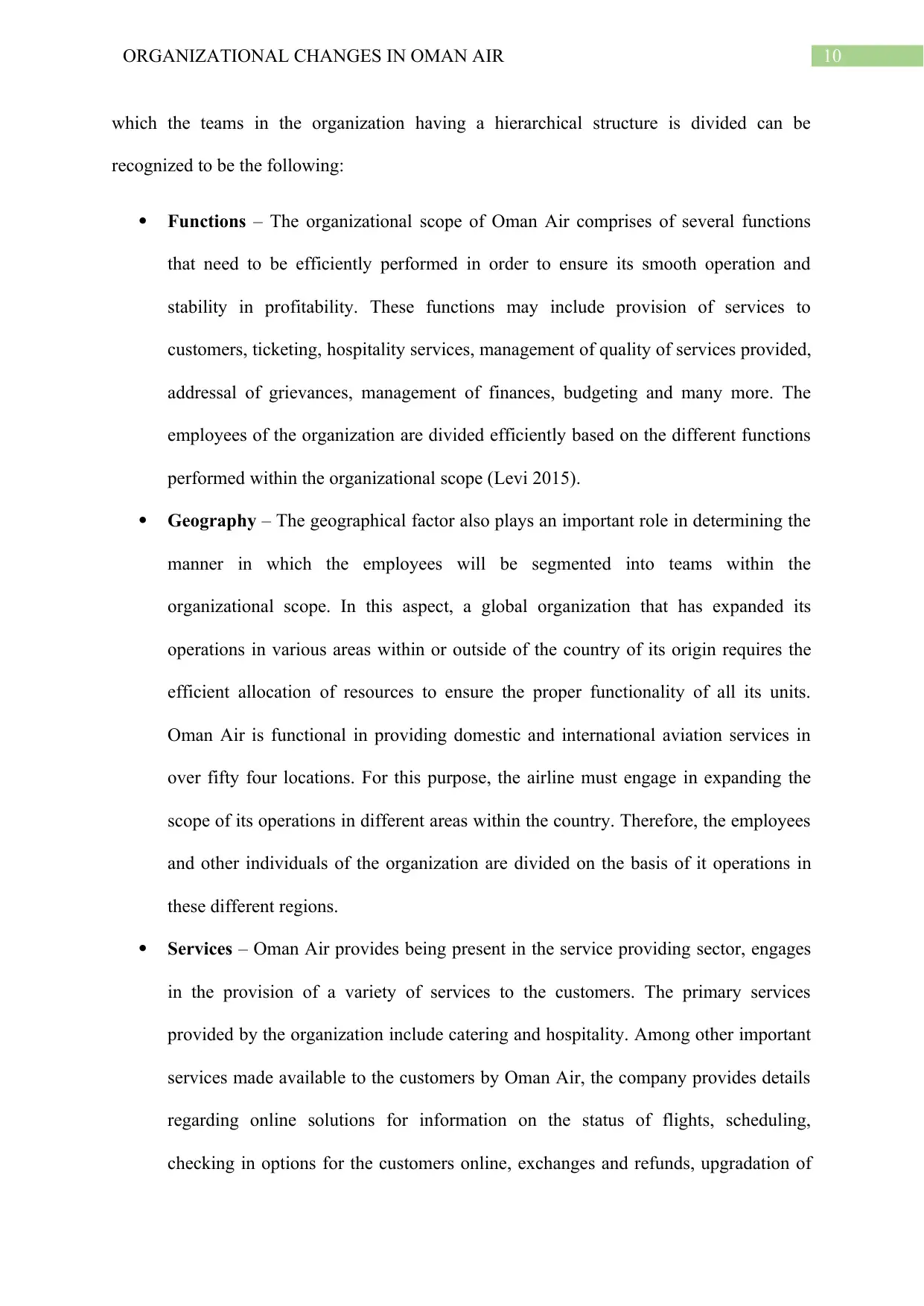
10ORGANIZATIONAL CHANGES IN OMAN AIR
which the teams in the organization having a hierarchical structure is divided can be
recognized to be the following:
Functions – The organizational scope of Oman Air comprises of several functions
that need to be efficiently performed in order to ensure its smooth operation and
stability in profitability. These functions may include provision of services to
customers, ticketing, hospitality services, management of quality of services provided,
addressal of grievances, management of finances, budgeting and many more. The
employees of the organization are divided efficiently based on the different functions
performed within the organizational scope (Levi 2015).
Geography – The geographical factor also plays an important role in determining the
manner in which the employees will be segmented into teams within the
organizational scope. In this aspect, a global organization that has expanded its
operations in various areas within or outside of the country of its origin requires the
efficient allocation of resources to ensure the proper functionality of all its units.
Oman Air is functional in providing domestic and international aviation services in
over fifty four locations. For this purpose, the airline must engage in expanding the
scope of its operations in different areas within the country. Therefore, the employees
and other individuals of the organization are divided on the basis of it operations in
these different regions.
Services – Oman Air provides being present in the service providing sector, engages
in the provision of a variety of services to the customers. The primary services
provided by the organization include catering and hospitality. Among other important
services made available to the customers by Oman Air, the company provides details
regarding online solutions for information on the status of flights, scheduling,
checking in options for the customers online, exchanges and refunds, upgradation of
which the teams in the organization having a hierarchical structure is divided can be
recognized to be the following:
Functions – The organizational scope of Oman Air comprises of several functions
that need to be efficiently performed in order to ensure its smooth operation and
stability in profitability. These functions may include provision of services to
customers, ticketing, hospitality services, management of quality of services provided,
addressal of grievances, management of finances, budgeting and many more. The
employees of the organization are divided efficiently based on the different functions
performed within the organizational scope (Levi 2015).
Geography – The geographical factor also plays an important role in determining the
manner in which the employees will be segmented into teams within the
organizational scope. In this aspect, a global organization that has expanded its
operations in various areas within or outside of the country of its origin requires the
efficient allocation of resources to ensure the proper functionality of all its units.
Oman Air is functional in providing domestic and international aviation services in
over fifty four locations. For this purpose, the airline must engage in expanding the
scope of its operations in different areas within the country. Therefore, the employees
and other individuals of the organization are divided on the basis of it operations in
these different regions.
Services – Oman Air provides being present in the service providing sector, engages
in the provision of a variety of services to the customers. The primary services
provided by the organization include catering and hospitality. Among other important
services made available to the customers by Oman Air, the company provides details
regarding online solutions for information on the status of flights, scheduling,
checking in options for the customers online, exchanges and refunds, upgradation of

11ORGANIZATIONAL CHANGES IN OMAN AIR
seats and baggage services (Guercini 2014). Such a variety of services provided by
the Company requires the allocation of employees and individuals into separate
sectors to ensure the efficiency of functioning and operations. The organizational
structure therefore takes into account the various services provided to the customers to
ensure efficiency in each sector, thereby maximizing the satisfaction of the customers.
The organizational structure in Oman Air therefore is observed to be comprising of the
Chief Executive Officer at its head who overlooks the functioning of the various segments
under it. The Chief Financial Officer directly reports to the CEO regarding the financial
actions, planning and decisions of the Company. The Chief Operating Officer further
oversees the operational and administrative functions and activities of the Company on a day
to day basis and reports directly to the Chief Executive Officer. There are separate teams that
overlook the Support Services and Sales of the Company and directly reports to the CEO.
Additionally, there are separate segments within the organizational structure for the managing
of Commercial activities, branding and brand image of the Company, Corporate and Business
development, Engineering and its maintenance, Human Resources Management and Media
and Communications.
The impact of the hierarchical organizational structure in Oman Air on the behavior of the
individuals of the organization shows that the management and decision making skills of the
managers and leaders enhances the performance of the employees. The segmentation of
teams in the organizational scope engages the employees to focus on certain areas of their
operation thereby improving their skills and performance in those areas (Hoch and Kozlowski
2014). Moreover, through the efficiency of the Human Resource Management System in the
organization, ensures that any grievances of the employees are addressed and resolved
adequately. These facilities provided to the employees through the hierarchical organizational
seats and baggage services (Guercini 2014). Such a variety of services provided by
the Company requires the allocation of employees and individuals into separate
sectors to ensure the efficiency of functioning and operations. The organizational
structure therefore takes into account the various services provided to the customers to
ensure efficiency in each sector, thereby maximizing the satisfaction of the customers.
The organizational structure in Oman Air therefore is observed to be comprising of the
Chief Executive Officer at its head who overlooks the functioning of the various segments
under it. The Chief Financial Officer directly reports to the CEO regarding the financial
actions, planning and decisions of the Company. The Chief Operating Officer further
oversees the operational and administrative functions and activities of the Company on a day
to day basis and reports directly to the Chief Executive Officer. There are separate teams that
overlook the Support Services and Sales of the Company and directly reports to the CEO.
Additionally, there are separate segments within the organizational structure for the managing
of Commercial activities, branding and brand image of the Company, Corporate and Business
development, Engineering and its maintenance, Human Resources Management and Media
and Communications.
The impact of the hierarchical organizational structure in Oman Air on the behavior of the
individuals of the organization shows that the management and decision making skills of the
managers and leaders enhances the performance of the employees. The segmentation of
teams in the organizational scope engages the employees to focus on certain areas of their
operation thereby improving their skills and performance in those areas (Hoch and Kozlowski
2014). Moreover, through the efficiency of the Human Resource Management System in the
organization, ensures that any grievances of the employees are addressed and resolved
adequately. These facilities provided to the employees through the hierarchical organizational
⊘ This is a preview!⊘
Do you want full access?
Subscribe today to unlock all pages.

Trusted by 1+ million students worldwide
1 out of 31
Related Documents
Your All-in-One AI-Powered Toolkit for Academic Success.
+13062052269
info@desklib.com
Available 24*7 on WhatsApp / Email
![[object Object]](/_next/static/media/star-bottom.7253800d.svg)
Unlock your academic potential
Copyright © 2020–2025 A2Z Services. All Rights Reserved. Developed and managed by ZUCOL.





